Why this resume works
- Quantifies accomplishments: This resume quantifies accomplishments by detailing specific figures, such as providing individualized therapy to over 200 pediatric patients annually and managing a caseload of over 50 students with IEPs.
- Highlights industry-specific skills: Features industry-specific healthcare skills, such as conducting evaluations and providing treatment for adults recovering from stroke, traumatic brain injury, and progressive neurological disorders.
- Showcases career progression: The chronological resume format showcases career progression, detailing the job seeker’s advancement from speech-language pathologist to senior speech-language pathologist with increasing responsibilities.
More Speech-Language Pathologist Resume Examples
Check out our speech-language pathologist resume examples to see how to highlight your therapy skills, patient communication experience, and clinical expertise. These samples will help you craft a medical resume that appeals to healthcare employers.
Entry-Level Speech-Language Pathologist
Why this resume works
- Centers on academic background: The education section includes relevant degrees from prestigious universities, underscoring the job seeker’s strong academic foundation early in their career.
- Touches on accomplishments: Showcases notable accomplishments that highlight the job seeker’s exceptional performance and contributions to the field, such as implementing therapy programs with a 92% session attendance rate.
- Includes relevant certifications: Lists relevant certifications, such as Dysphagia Management for SLPs and Clinical Competence, demonstrating a high level of proficiency with modern therapeutic methods.
Mid-Level Speech-Language Pathologist
Why this resume works
- Demonstrates specialized abilities: Details specialization in pediatric speech and language disorders, augmentative and alternative communication (AAC), and early intervention, highlighting industry-specific skills and experience.
- Hones in on real impact: Spotlights tangible impact in past roles, including delivering speech therapy to over 55 elementary school students with IEPs, which resulted in a 95% annual IEP goal attainment rate.
- Displays technical expertise: Highlights technical skills such as conducting standardized assessments alongside highly relevant skills like therapeutic techniques and case management.
Experienced Speech-Language Pathologist
Why this resume works
- Focuses on work history: This resume uses a chronological format to emphasize extensive work history, detailing progressive roles and responsibilities ideal for highlighting a seasoned professional’s career journey.
- Showcases impressive accomplishments: Significant achievements such as implementing therapy plans that increased progress by 25% demonstrate the job seeker’s ability to make impactful contributions at a senior level.
- Emphasizes leadership skills: Underscores leadership skills through accomplishments like supervising clinical fellowship trainees and leading multidisciplinary teams, showcasing the ability to guide and influence others effectively.
Speech-Language Pathologist Resume Template (Text Version)
EMILY RIVERA, M.S., CCC-SLP
Address: Los Banos, CA 93635
Phone: 555-555-5555, 555-555-5555
Email: example@example.com
Professional Summary
Dedicated and compassionate speech-language pathologist with over 15 years of clinical experience serving pediatric, adult, and geriatric populations in school, hospital, and private practice settings. Skilled in diagnosing and treating a wide range of communication and swallowing disorders. Proven track record of improving patient outcomes by 40% on average and implementing evidence-based practices. Committed to patient-centered care, interdisciplinary collaboration, and continuing professional development.
Work History
Senior Speech-Language Pathologist, 07/2016 to Current
Valley Children’s Healthcare – Los Banos, CA
- Provide individualized speech, language, and feeding therapy to over 200 pediatric patients annually, achieving measurable progress in 89% of treatment plans.
- Mentor and supervise a team of five junior SLPs and three graduate interns, resulting in a 100% intern program completion rate.
- Implement group therapy sessions for individuals with similar communication challenges, promoting peer support and increased motivation.
Speech-Language Pathologist, 08/2010 to 06/2016
Los Banos Unified School District – Los Banos, CA
- Managed a caseload of 50+ students with IEPs, improving expressive and receptive language scores by an average of 35% within one academic year.
- Collaborated with multidisciplinary teams to develop and monitor individualized educational plans (IEPs), achieving 100% compliance with district and state regulations.
- Introduced interactive AAC device training sessions, increasing classroom communication participation by 60% among non-verbal students.
Speech-Language Pathologist – CFY and Staff Clinic, 09/2008 to 07/2010
Central Valley Rehabilitation – Fresno, CA
- Conducted evaluations and provided treatment for adults recovering from stroke, traumatic brain injury, and progressive neurological conditions.
- Reduced aspiration risks in dysphagia patients by 45% through the implementation of customized feeding protocols.
- Facilitated family training and discharge planning for over 100 patients, ensuring a 90% home transition success rate without re-admission.
Skills
- Pediatric and adult therapy
- Dysphagia management
- Augmentative and Alternative Communication (AAC)
- IEP development and compliance
- Fluency and voice disorders
- Cognitive-communication therapy
- Telepractice and digital documentation
Certifications and Licenses
- Certificate of Clinical Competence in Speech-Language Pathology (CCC-SLP) – ASHA
- California State License – Speech-Language Pathology
- CPR & First Aid Certified
- PROMPT Trained Therapist
- Hanen Certified (“It Takes Two to Talk” Program)
Education
Master of Science, Speech-Language Pathology
California State University – Fresno, CA
Bachelor of Arts, Communicative Disorders
California State University – Fresno, CA
Related Resume Guides
- Clinical Documentation Improvement Specialist
- Clinical Project Manager
- Clinical Research Assistant
- Clinical Trial Associate
- Coding Specialist
- Dermatologist
- Dialysis Technician
- Doctor
- Electrocardiograph Technician
- Emergency Department Technician
- Emergency Room Registration Clerk
- Equipment Technician
- Health Information Technician
- Hospital Administrator
- Hospital Volunteer
- Intake Coordinator
- Intensive Care Physician
- Medical Laboratory Technologist
- Medical Records Specialist
- Medical Representative
- Medical Research Assistant
- Midwife
- MRI Technologist
- Neurosurgeon
- Nuclear Medicine Technologist
- OB-GYN Medical Assistant
- Ophthalmologist
- Ophthalmology Assistant
- Optometrist
- Orthopedic Surgeon
- Pediatric Assistant
- Pediatrician
- Physician
- Physician Assistant
- Podiatrist
- Psychiatrist
- Radiologist
- Radiology Technician
- Resident Medical Officer
- Respiratory Therapist
- Surgeon
- Surgery Scheduler
- Ultrasound Technician
Advice for Writing Your Speech-Language Pathologist Resume
Explore our tailored advice on how to write a resume and discover how to highlight your unique skills and experiences. We’ll help you craft a standout resume that showcases your expertise in communication disorders and dedication to improving patients’ lives.
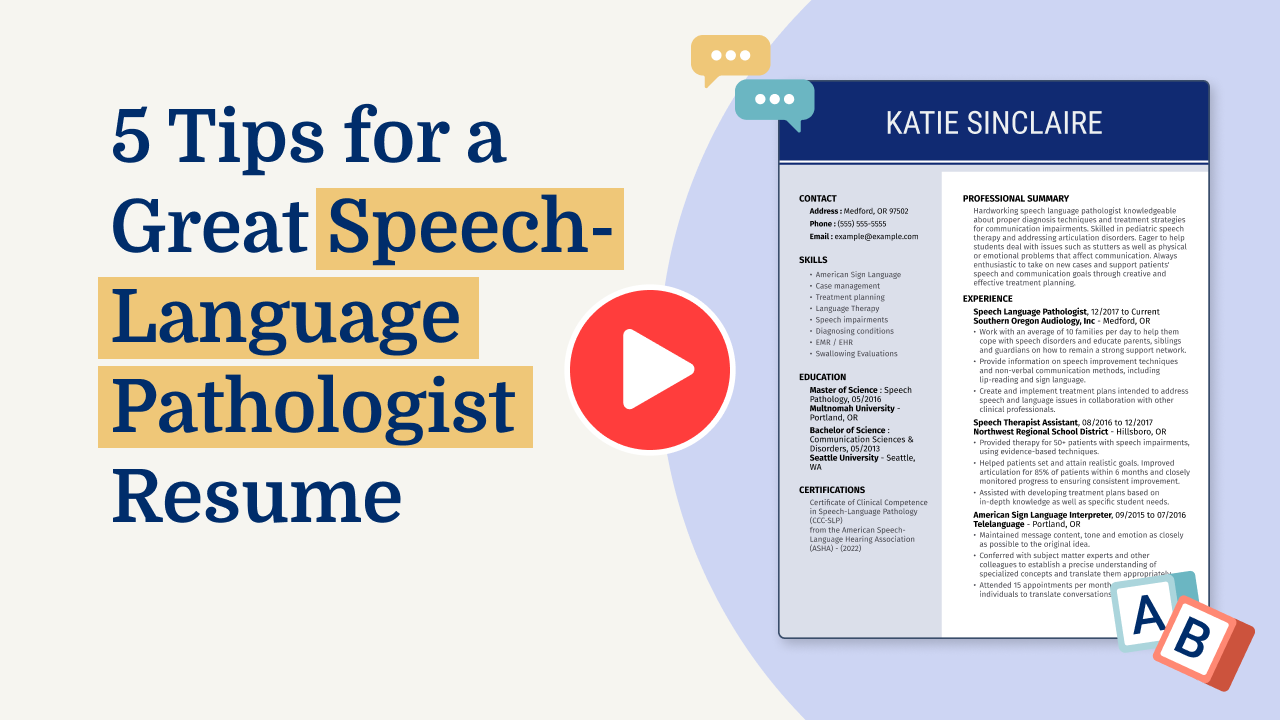
Write a strong professional summary
A professional summary at the top of your resume emphasizes your key skills and experiences as a speech-language pathologist to stand out to hiring managers right away. For those with ample experience, it should underscore major accomplishments and expertise in the field.
If you lack extensive work experience, consider using a resume objective instead to highlight your career aspirations and how they match the job you’re seeking. Use dynamic language to stress your abilities and potential contributions, such as “eager to use,” “passionate about,” or “committed to improving.” Mention any internships, volunteer roles, or academic projects to showcase your preparedness for the role.
Whether crafting a professional summary or an objective, include specific skills like patient assessment, creating individualized treatment plans, and enhancing communication techniques. This will help organize your sections and highlight achievements relevant to speech-language pathologist roles.
Speech-language pathologist resume summary examples
Entry-level
Recent master’s degree graduate in speech-language pathology with hands-on experience from supervised clinical practicum. ASHA-certified and proficient in evaluating and treating speech, language, and swallowing disorders across diverse age groups. Passionate about using evidence-based practices to support communication skills development and enhance patient quality of life.
Mid-career
Dedicated speech-language pathologist with 5+ years of experience working in school settings and private practice. Expertise in diagnosing and treating various speech and language disorders, including articulation, fluency, and voice issues. Licensed practitioner known for developing individualized treatment plans, collaborating with educators and families, and achieving measurable improvements in communication abilities.
Experienced
Highly experienced speech-language pathologist with over 15 years specializing in pediatric speech disorders and augmentative communication systems. Proven track record of leading multidisciplinary teams, conducting advanced diagnostic assessments, and implementing innovative therapeutic interventions. Recognized for significant contributions to research publications and commitment to advancing the field through mentorship and professional development initiatives.
Speech-language pathologist resume objective examples
Recent graduate
Recent graduate with a master’s degree in speech-language pathology, eager to begin career in a supportive and dynamic clinical environment. Dedicated to using academic knowledge and hands-on clinical experience to diagnose and treat speech and language disorders in children and adults while contributing positively to the team.
Career changer
Passionate educator transitioning into a career as a speech-language pathologist, bringing extensive experience in communication skills, child development, and individualized instruction. Committed to leveraging this background and freshly acquired speech-language pathology training to support diverse patient needs and improve their communication abilities.
Specialized training
Certified speech-language pathologist with specialized training in augmentative and alternative communication (AAC) seeking an opportunity within a forward-thinking healthcare facility. Aiming to apply skills in AAC systems, alongside strong assessment and intervention capabilities, to help clients enhance their communicative functions effectively.
You can use our Resume Builder to easily create a resume that effectively highlights your speech therapy skills and experience.
Include relevant certifications and training
Listing certifications, licenses, and specialized training is crucial for a speech-language pathologist. These credentials show your expertise and dedication to the field. They also assure employers that you meet industry standards. Create a dedicated certifications section on your resume to highlight these qualifications.
Here are some examples of relevant certifications and licenses for a speech-language pathologist:
- Certificate of Clinical Competence in Speech-Language Pathology (CCC-SLP)
- State licensure in speech-language pathology
- Bilingual Extension Certificate
- Certified Swallowing Specialist
List each certification with its full name, the issuing organization, and the date obtained or expiration date, if applicable. Organize them in reverse chronological order to keep the most recent and relevant at the top.
Example of a certifications section
Certificate of Clinical Competence in Speech-Language Pathology (CCC-SLP)
Issued by: American Speech-Language-Hearing Association (ASHA)
Issued 2022
Licensed Speech-Language Pathologist
Issued by: State Board of Examiners for Speech-Language Pathology and Audiology
Expires 2025
Board Certified Specialist in Child Language (BCS-CL)
Issued by: American Board of Child Language and Language Disorders
Issued 2021
Dysphagia Specialist Certification
Issued by: Swallowing and Swallowing Disorders (Dysphagia) Committee
Issued 2023
We recommend using one of our resume templates to create a polished and professional resume that stands out to hiring managers in your field.
Showcase your work experience
A strong work experience section is essential for a speech-language pathologist resume. It allows employers to see your achievements and how your skills match the job. List your experience in reverse chronological order, starting with your latest job.
Use action verbs when detailing past roles. For instance, instead of saying “responsible for,” use terms like “developed and implemented,” “conducted assessments,” or “collaborated with.” Include measurable outcomes to demonstrate the impact of your work, such as “increased patient progress by 20% through tailored therapy plans.”
When outlining core responsibilities, emphasize job-specific skills like diagnosing speech disorders, creating treatment plans, providing therapy sessions, and educating families. Format each entry similarly to the following example:
Speech-Language Pathologist – City Hospital New York, NY
June 2019 – Present
- Conducted comprehensive speech and language evaluations for over 50 patients monthly.
- Developed individualized treatment plans that improved patient communication abilities by an average of 15%.
- Collaborated with multidisciplinary teams to provide holistic care.
5 speech-language pathologist work history bullet points
- Conducted comprehensive speech and language assessments for 50+ patients monthly, resulting in the development of individualized treatment plans that improved communication skills by 40%.
- Collaborated with interdisciplinary teams to provide holistic care, leading to a 25% increase in patient satisfaction scores.
- Implemented innovative therapy techniques, decreasing treatment duration by an average of 2 weeks for pediatric clients.
- Provided training and support to caregivers, enhancing their ability to facilitate at-home practice and achieving a 30% improvement in patient progress.
- Maintained detailed patient records and progress reports, ensuring compliance with healthcare regulations and contributing to a 99% accuracy rate in documentation.
Using relevant keywords from the job posting in your resume can help it get through ATS and catch the eye of recruiters.
Match your resume with the job description
Customizing your resume to align with job descriptions is crucial because it helps your application stand out to hiring managers and applicant tracking systems (ATS).
By incorporating the same keywords and phrases in the job posting, you demonstrate that you possess the specific skills and experiences they seek. Explore our ATS-friendly resume guide for additional tips and examples.
Start by identifying key terms in the job description, such as required skills, qualifications, and responsibilities. For instance, if a job listing mentions “experience with pediatric patients” and “developing individualized treatment plans,” ensure these phrases are present in your resume.
Integrate these terms into relevant sections of your resume. For example, if the job posting specifies “provide therapy to children with speech disorders,” you can rephrase it as: “Provided targeted speech therapy to children with various speech disorders, enhancing their communication abilities.”
This approach can help you create a targeted resume that aligns with the job description and effectively showcases your accomplishments. Use bullet points for easy readability and emphasize measurable outcomes to illustrate your impact.
Use our ATS Resume Checker to find and fix common mistakes, missing keywords, and other issues before you send it to hiring managers.
FAQ
Do I need to include a cover letter with my speech-language pathologist resume?
Yes, it is highly recommended that you include a speech-language pathologist cover letter with your resume. A well-crafted cover letter allows you to go beyond your resume by expressing your enthusiasm for the role and highlighting how your specific skills and experience make you a strong fit.
For example, if you’ve worked extensively with children with autism or led therapy groups in a school or clinical setting, a cover letter allows you to tell that story in a way that feels personal and compelling. Our Cover Letter Generator and expertly crafted cover letter examples can help you create a tailored letter that sets you apart from other applicants.
How long should a speech-language pathologist resume be?
A speech-language pathologist (SLP) resume is typically one to two pages long, depending on your experience level.
Entry-level or early-career speech-language pathologists should aim for one page, focusing on education, clinical fellowships, relevant coursework, and any hands-on experience. Professionals with more expertise can use a two-page resume to detail advanced skills and achievements.
Focus on current and pertinent experiences like successful therapy outcomes or innovative methods you’ve implemented. Explore our guide on resume length for more tips.
How do you write a speech-language pathologist resume with no experience?
For those just starting out as speech-language pathologists, it’s essential to emphasize your education, relevant coursework, and hands-on training. Here’s how to craft your resume:
- Begin with your speech-language pathology or communication sciences and disorders degree. Include the institution’s name, graduation date, and any honors received.
- Thoroughly detail your clinical practicum experiences, specifying the settings (schools, hospitals), populations served (children, adults), and therapies or assessments conducted.
- Highlight transferable skills such as patient communication, assessment techniques, treatment planning, and documentation. Include roles in related fields like tutoring or coaching to showcase interpersonal and organizational abilities.
- List certifications such as ASHA membership or state licensure. Mention CPR/First Aid certification if applicable.
- Include professional development activities like workshops, seminars, or conferences in speech-language pathology to demonstrate ongoing learning.
Explore our guide on writing a resume with no experience for additional tips and examples from career advice experts.
Additional Resources

Essential Language Skills for Your Resume (Examples & Tips)
Language skills are crucial in today’s globalized world. They enable effective cross-cultural communication, facilitate understanding and drive international business success. We’ll explore various examples of language skills and offer tips on
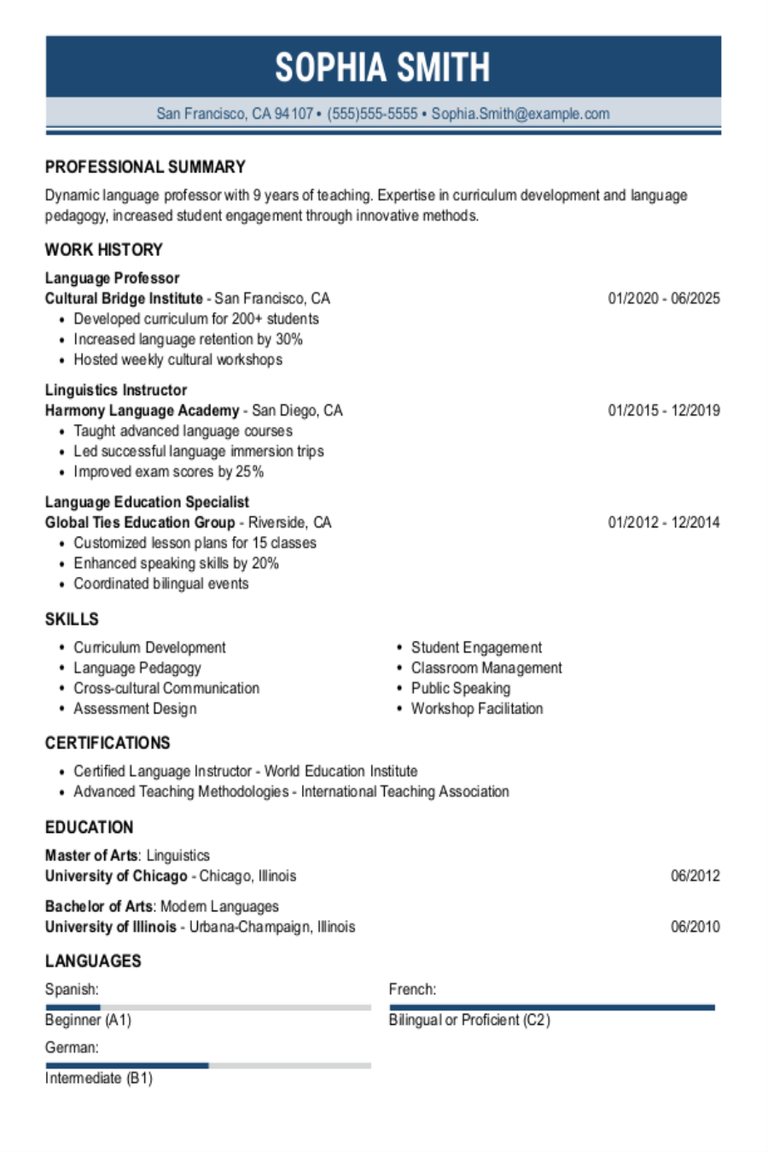
Language Professor Resume Examples & Templates for 2025
Explore language professor resume examples to see how to showcase your teaching skills and cultural knowledge. Browse tips to help you highlight your classroom experience and passion for languages to
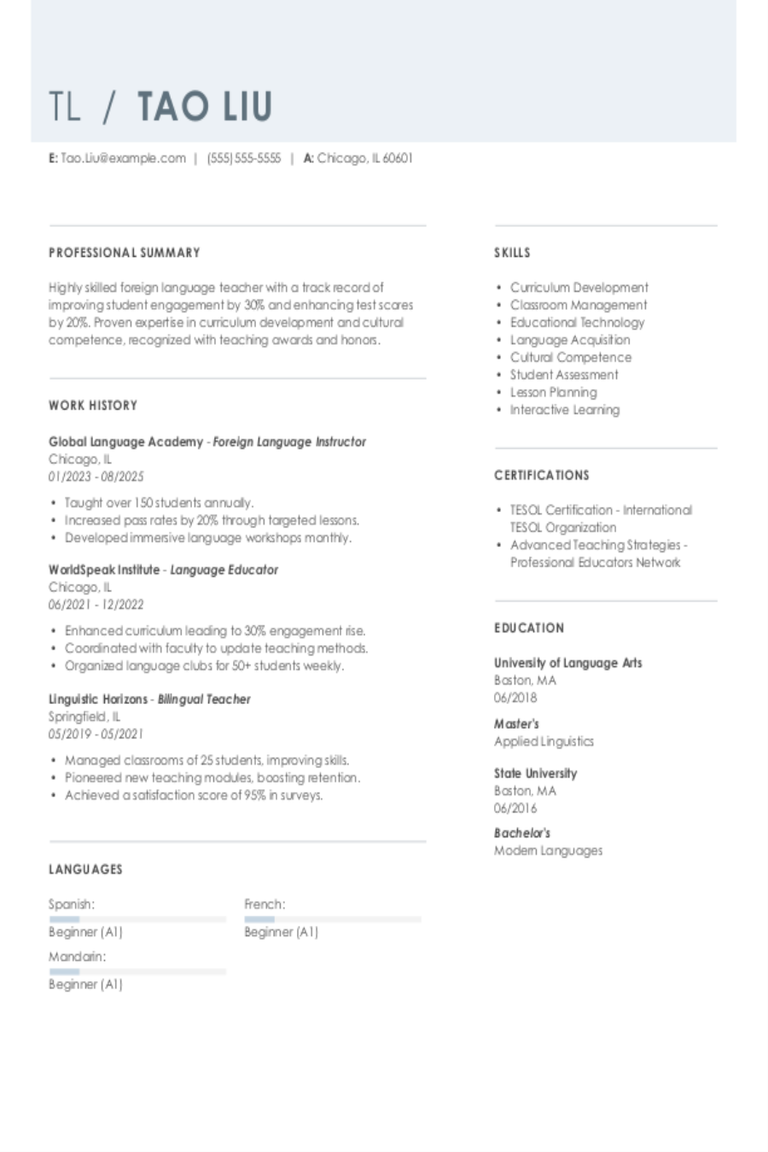
Foreign Language Teacher Resume Examples & Templates for 2025
Explore foreign language teacher resume examples that demonstrate how to showcase your teaching skills and language expertise. These tips can help you highlight your experience effectively and make your resume
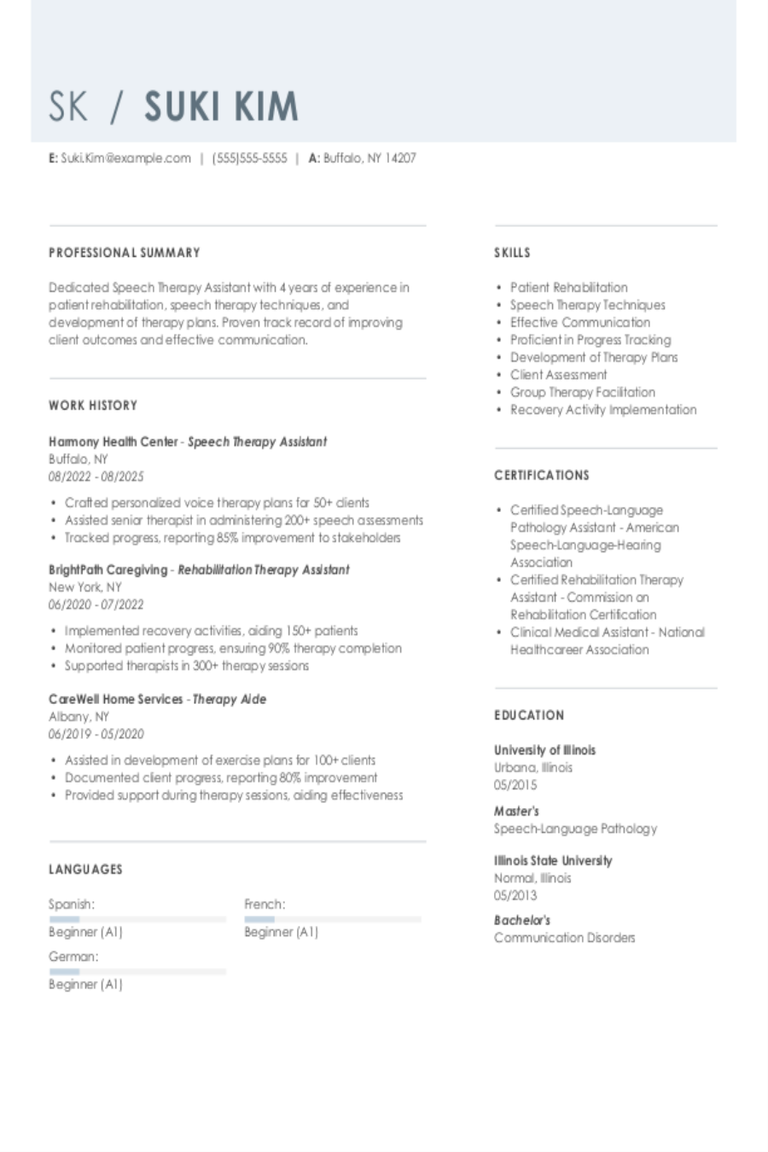
Speech Therapy Assistant Resume Examples & Templates for 2025
Explore speech therapy assistant resume examples and tips that will guide you in highlighting your skills and experiences clearly and effectively.Build my resumeImport existing resumeCustomize this templateWhy this resume worksHighlights
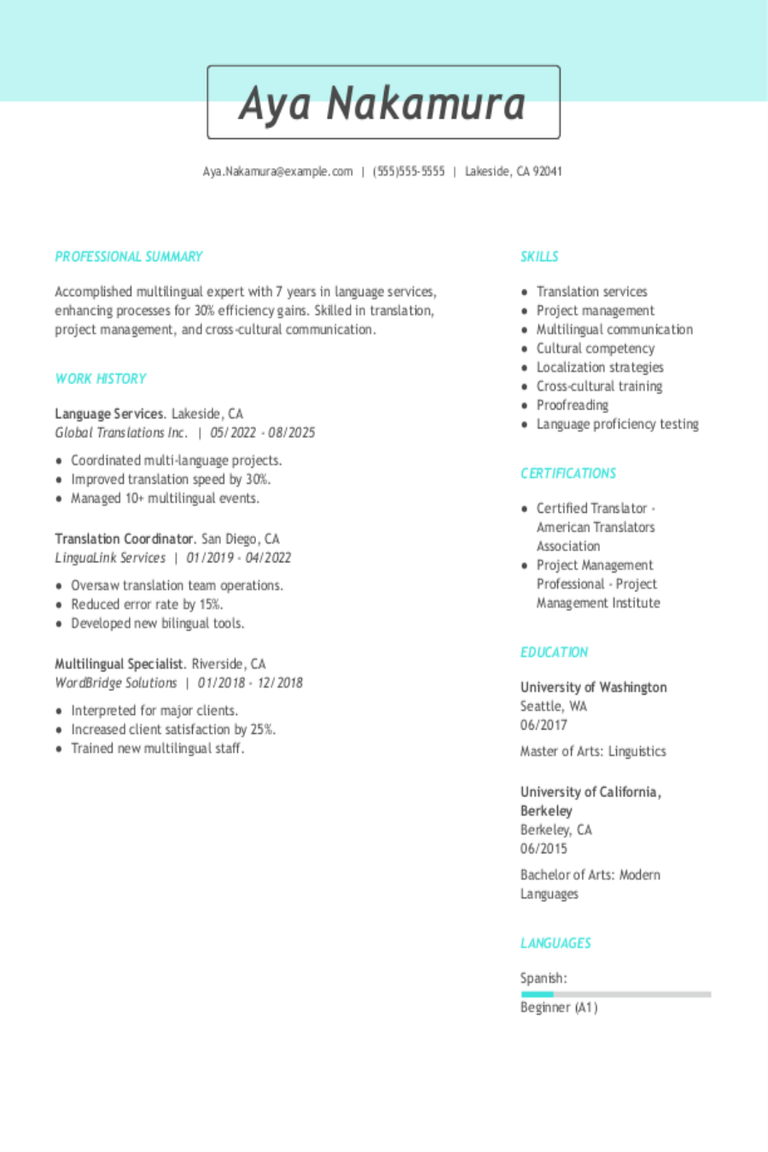
Language Services Resume Examples & Templates for 2025
Explore language services resume examples that showcase translation skills, cultural knowledge, and attention to detail. Learn how to present yourself as a skilled communicator ready for any language challenge to

Freedom of Speech at Work? 74% of Employees Say They Self-Censor
Despite corporate messaging promoting authenticity, most employees are staying silent. A new survey of 1,000 U.S. workers by MyPerfectResume reveals that freedom of expression at work is more aspirational than
